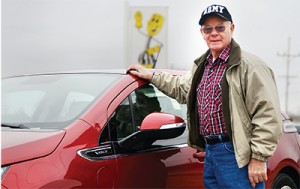 No Unwieldy extension cord flails from the rear of Mary Gibbs’ Chevrolet Volt as it silently slips through the rolling Harrison County countryside on her workday commute.
No Unwieldy extension cord flails from the rear of Mary Gibbs’ Chevrolet Volt as it silently slips through the rolling Harrison County countryside on her workday commute.
Nor does the car shudder to a halt when that mythic cord stretches to its limit and rips itself from the outlet in her garage.
But from the comments she gets about her car, it seems some people think both things are plausible, at least figuratively.
People will say to her, “Well, you’re tethered to that plug.”
She tells them, “No you’re not. You can drive from here to California if you want.”
Or someone will ask her, “Doesn’t it bother you every time you get to work you’ve got to plug it in?”
She asks them, “Does it bother you every time you’ve got to stop and fill up with gas?”
Gibbs, a Harrison REMC consumer from Palmyra, has put almost 22,000 miles on her Volt since purchasing it in early 2012. She is among the earliest adopters nationwide to get behind the wheel of an electric car.
Technically, her 2012 Volt is a plug-in hybrid electric vehicle, or PHEV. When fully charged, the Volt’s lithium-ion battery pack will power its electric motor for 38 miles or so. When the pack is depleted, an onboard gasoline generator seamlessly powers the motor for as far as she wants to go — for well over 300 more miles.
Then, like with most cars, she needs to pull into a gas station to refill the generator’s 9-gallon tank, or, unlike with most cars, she recharges the batteries by plugging her car into any 120-volt outlet. Gibbs prefers doing the latter as much as possible.
The more she runs the Volt on 10-cent kilowatt-hours instead of $3.60 gallons of gas, the more she saves. This potential for savings on her 70-mile round-trip commute helped her and husband Jim decide on the Volt when they searched for her new car a year ago.
“I thought if I could drive it to work, plug it in and drive it home, I’m not going to use any gas. At that time, they were talking about gas maybe hitting $5 a gallon. I thought that would make my car payment.”
In addition, the more electricity powers her car, the less emissions she puts into the air and the less she contributes to our nation’s dependence upon foreign oil. “I’ve made a commitment to get as much as I can out of it and drive it in the best way possible,” she said.
Electrics hit the highway
Though scarcely 50,000 drivers nationwide have made a similar commitment to the Volt or the all-electric Nissan Leaf since their introductions two years ago, sales began picking up in 2012.
The two, the first mass-produced electric cars off the lot, were introduced in 2011 to a curious public but to tepid sales. Sticker shock — upper $30,000s for the Leaf and over $40,000 for the Volt — along with limits on their size and performance kept buyers away.
While still a niche market, PHEV and electric vehicles — especially the Volt — saw a significant jump in sales last year. General Motors says it sold 23,461 Volts in 2012, three times as many as in 2011. The Volt still is one of Chevy’s lowest-selling vehicles, but it outsold the iconic Corvette last year by over 9,000 cars.
Last year, the Volt also jumped well ahead of the Leaf in sales. Nissan sold about 9,800 Leafs in 2012, a small increase over 2011 sales.
While more than half of Volt sales are in California, the car has also been catching on in other markets. That’s been due in part to GM’s aggressive leasing packages, financing and other incentives to help bring down the sticker price. In addition, both the Volt and Leaf are eligible for the federal tax incentive of up to $7,500.
While some smaller electric car makers, like the European-based THINK, which made the North American version of its two-seat commuter in northern Indiana, have gone bankrupt or fallen by the wayside recently, Chevy and Nissan soldier on and seem committed for the long haul. They have found their strongest support among those who have purchased or leased a Volt or Leaf, according to customer satisfaction surveys.
Even though sales are slow, and some reports estimate GM is actually losing more than it makes on each Volt it does sell, a second wave of electric vehicles and PHEVs by other car makers, like Ford, Honda, Toyota and Volkswagen, is gearing up. Some 20 varieties of EV and PHEVs could be available by 2014.
Electric vehicle evangelist
Bob Switzer may not fit the “marketing profile” of the typical electric car buyer, someone under 50. But that doesn’t make the 79-year-old retiree from Adams County any less enthusiastic. In fact, since he bought his Volt in December 2011, you could say he’s become a bit of an “EV-angelist,” spreading its benefits to all who’ll listen.
Switzer has been quick to let interested folks around Geneva get behind the wheel. “My wife says everybody in the county’s drove it — but not quite,” he noted. “Some were from Jay County.”
He’s shown off the car at Jay County REMC and let employees take it for a spin around the parking lot and brought it to the REMC’s annual meeting.
Switzer said he’s always been intrigued with electric cars and their technology. He put his name in for GM’s EV1 in the late 1990s, though the short-lived all-electric two-seater was leased only in California and Arizona. Five years ago, when he heard GM was working on the Volt, he put his name on its waiting list.
Now that he’s driven his Volt almost 17,000 miles, averaging around 107 miles per gallon, his love for the car goes back to the simple act of driving. “The ride is really what impresses me now,” he said. “We had a Lincoln Town Car. I will say that it rode nice, too. But as far as driving, I would rather drive this than the Lincoln.”
In fact, Switzer said, “This is the best-driving car I’ve ever had. The steering’s quick. It’s easy. There’s no vibration.”
And, he notes, there’s no herking and jerking with the Volt as it accelerates. “A regular transmission, you’ll feel it shifting and you know where it’s at.” The Volt is so smooth, he warned, it would be easy to get a ticket if you’re not paying attention. “You’ll get to speed before you realize it.”
Car with a ‘place’
Unlike Switzer, Jim and Mary Gibbs weren’t looking for an electric car last year when they decided to trade in two Pontiacs, a G6 and the two-seat Solstice, for one new car. Jim, who’s retired, still had his pickup. So, Mary set the criteria for the new car she would be driving to work each day in Jeffersonville. Her goals: It had to get over 40 miles per gallon — to help reduce the $50 a week she’d been spending on gas; and it had to be U.S.-made.
They looked at the Toyota Prius and other traditional hybrids that efficiently combine both a battery-powered motor and a gas-powered engine. But she said they could find none made primarily in the U.S. That’s when they turned to the Michigan-made Volt.
Gibbs said she knew the mileage limitation on the batteries and the sticker price wouldn’t make economic sense unless her employer, Industrial Air Centers, allowed her to plug it in during the day to give her a full charge for the drive home. The company, which sells, services and rents industrial air compressors, gave her the OK to use an outside outlet by the back door.
A full recharge on the Volt is about 9-10 kWh. That’s a cost of about 90 cents to $1. Essentially, she’s traveling 70 miles a day to and from work for about $2 in electricity. Gas, for even an efficient compact, would be $7.20 — or more.
She likes the Volt’s looks and performance. “It’s extremely peppy. You don’t even know you’re going as fast as what you’re going.”
Jim likes its reliability. “Maybe it’s too early, but the Volt seems to be extremely high quality.”
She also likes the statement the car makes. “I liked both my Pontiacs, and I thought if I’m going to give them up, I’m going to go all out,” she said. “Why not do something! So that’s what I did.”
Approaching 22,000 miles in just over a year, her Volt is averaging around 199 miles per gallon. The mpg is so high because she uses gas on just the occasional weekend drive to Louisville. She relies mostly on the batteries, coaxing every mile out of them as if the gas backup wasn’t there.
She even shuns the car’s heater, which is a big drain on the batteries. On cold days, she said she’s fine with a blanket across her lap and gloves. She also drives through town. While it takes a little longer to get home, the stop and go of city driving, and the Volt’s regenerative braking, helps recharge the batteries, too.
“For what I got the Volt for,” Gibbs said, “it’s everything I thought it would be. I hope people would give electric vehicles a chance. I don’t think they’re for everybody. But for people who maybe live in the city or like me, I think the electric car definitely has a place.”
The ‘Model Ts’ of this technology
Jeff Quyle would say Gibbs commutes in that “sweet spot” for the Volt, that perfect place right at the edge of its battery range. Getting to recharge it while at work is another bonus.
He’s in the same zone. His commute to Hoosier Energy REC, where he’s the economic development coordinator, is right at 34 miles. Hoosier Energy has four 240-volt recharging stations in its parking lot which recharge a car in half the time as a 120-volt outlet.
That’s why in January Quyle took advantage of GM incentives and purchased a 2013 Volt to replace a Ford Escape hybrid with 190,000 miles. Using dealer incentives, a whopping $4,000 worth of points from a GM credit card, the $7,500 federal tax credit (which he’ll take off next year), plus zero percent financing, he purchased the Volt for the equivalent of about $25,000 — more than a third off the sticker price.
And big savings keep coming at the gas station, too. “It’s saving me 250 bucks a month in fuel easily,” Quyle said. And he notes the hybrid he replaced got a none-too-shabby 35 mpg.
Parked next to Quyle’s silver Volt each day at Hoosier Energy’s charging stations is Paul Cummings’ silver Nissan Leaf. He leased the 2012 model in February.
Through dealer incentives and the $7,500 tax incentive, Cummings was able to drive the $38,000 car home for a $28,000 lease. He noted Nissan has since lowered the price on the Leaf. With incentives, he noted, a person can get into a Leaf for around $21,000.
Cummings’ role at Hoosier Energy is renewable energy analyst. He said his next vehicle was going to be electric, but that decision had less to do with his job than the pickup he was replacing. “It was eating me alive on gas,” he noted.
Cummings lives in Owen County. His drive to Hoosier Energy’s Bloomington office is about 17 miles one way. The range of the all-electric Leaf is 73-96 miles per charge. Cummings expects it’ll reach over 100 in summer when the warmer weather is more favorable to the batteries.
The Volt would have been his first choice, for its added practicality of the gas generator. But Cummings and his wife have three young kids at home. He needed a back seat for three. The Volt’s back sits only two.
Besides its sticker price, Danny Arnold, CEO at Orange County REMC, said the Volt’s size is its biggest drawback. The Orleans-based REMC has been one of four REMCs leasing a Volt through Hoosier Energy’s renewables grant program since late 2011. “It’s a great vehicle if most of your driving is short hauls and you don’t have a large family. If your name is ‘Zeller,’ and you and the Mrs. are going to take the three boys out to McDonald’s, a Volt is not the car for you,” Arnold said, noting Indiana’s famed basketball family.
While neither Quyle nor Cummings have had their electric cars long, both cars have earned their endorsement. “To cut to the chase, it is definitely ready for prime time,” Cummings said. “It’s easily the best car I’ve ever had. It’s built like a luxury car.”
“I also love how technologically advanced the car is,” Quyle said, “with Bluetooth sync, hands-free calling, XM radio. It makes driving a lot of fun.”
Both also have apps for their smart phones that communicate with their cars and provide all the battery and other data. They can remotely start the cars to warm them up or cool them down before coming out to unplug them. Cummings’ Leaf calls him and lets him know when it’s done fully recharging.
This enhanced technology is certainly available in other cars. But Purdue University professor Vahid Motevalli, the founding director for Purdue’s Center for Technology Development, noted that it was the federal government’s investment in electric vehicle research 20 years ago, which he was a part of, that helped transform the entire auto industry. The research helped the development of the Toyota Prius, the first hybrid family sedan, and even led to today’s cleaner burning, more efficient gas and diesel engines.
While he noted that the Leaf and Volt are acceptable right now for some, the innovations must keep coming for EVs to gain wider acceptance, especially in smaller towns and rural areas. Motevalli said much needs to be done to improve the range and reduce the costs.
Meanwhile, he said, it’s not just all about batteries and electricity. Exploration into advanced hydraulics and other propulsion systems is being done as well. Some of it is taking place at the nation’s leading engineering schools like Purdue and Rose-Hulman Institute of Technology.
“We’re in the infancy of the technology,” said Quyle. He noted the Volt works perfectly for him because he’s truly in a perfect place with driving distance and access to a charging station. “It’s not going to be the perfect vehicle for every person who fantasizes about driving completely electric and being able to go long distances.
“But a full charge for me is less than 10 kilowatt-hours,” Quyle added. “You’re talking less than a dollar a night to charge, and that takes me 40 miles at this point. Basically, I’m getting the equivalent of a gallon of gasoline for 90 cents.”
“These cars are like the Model Ts of electric cars,” added Cummings. “It’s just going to get a lot better in a hurry.”



